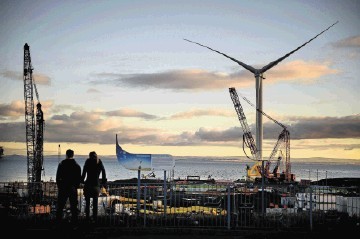
Wind energy can make a significant contribution to electricity supply in the UK . . . up to about 20% of consumption by 2020 based on current estimates according to new research.
The Royal Academy of Engineering reports that the system will remain secure to that point using the power supply balancing mechanisms already in place.
Though technical issues will arise, such as those relating to system inertia and frequency control, the RAE says these will be manageable if given sufficient consideration.
However, the Academy reports that, at current fuel and carbon prices, onshore wind energy remains more expensive than gas or coal plant but is one of the cheapest low carbon sources of electricity.
Offshore wind is more expensive, as reflected in the strike prices offered for the new Contracts for Difference feed-in tariffs, but shows potential for cost reduction.
RAE says: “The ultimate effect of wind energy on the price of energy to consumers is difficult to evaluate precisely because of inherent limitations and uncertainties in calculating current and future energy costs.”
It points out that energy systems and technologies are global in nature and several countries are ahead of the UK in aspects of developing wind energy and warns that lessons should be learned.
The UK has the third highest amount of installed wind capacity in the EU, similar in scale to France and Italy but significantly less than Germany and Spain, which have three to four times more installed capacity.
In 2013, wind produced 21.1% of Spain’s electricity – more than any other form of generation. Denmark, while lower in terms of installed capacity, has the highest levels of wind penetration at over 25%.
Globally, as of 2013, there were 318GW of wind capacity. China and the US together made up almost half of that total with the UK accounting for just over 3%.
Where the UK does lead is in offshore wind, with over half of the global capacity at the end of 2012. However, the RAE observes that this still only accounts for about 2% of global installed wind capacity, indicating that offshore wind is at a very early stage of deployment compared to onshore wind.
The Academy also says there are various ways of measuring the UK’s global ranking including installed capacity per person or per unit of GDP. This shows us in a poorer light.
“Relative to the number of people in the country, the UK is just outside the top 10 and, in terms of GDP, the UK is about 20th in the world,” says the RAE.
“In both cases, countries such as Denmark, Portugal, Germany and Ireland are significantly ahead of the UK in terms of installed wind capacity.”
The RAE is clear that the wind industry needs clarity and confidence in the regulatory regime and support mechanisms.
“The completion of legislation to enact Electricity Market Reform is encouraging but it needs to be implemented without delay and the trajectory to decarbonise the grid made clear as part of the next Carbon Budget,” it says.
“Long-term, cross-party consensus on future energy policy will be vital to ensuring sufficient investment and establishing a UK supply chain.”
The Academy says that, by 2030, a wholesale transformation of the UK energy system will be required if government targets on carbon emissions are to be met.
Integrating higher levels of wind energy will be one challenge among many.
As well as low carbon generation such as wind energy, the future system would need to deploy such tools as demand reduction and management, flexible generation, interconnection, and storage. Significant changes in heating and transport are also expected.
However, it warns that overcoming such challenges requires a “fundamental shift in society’s attitude to and use of energy and will only be met with the support of both domestic and business customers”.
“High levels of wind energy will result in large numbers of very large turbines. Whether these are onshore or at sea, they will inevitably have an impact on local communities and stakeholders,” says the RAE.
“Government and industry must both play their respective parts in engaging honestly with these stakeholders, setting out clearly both the impacts and the benefits.”
Moreover, the RAE is clear that government “must take the strategic lead” in preparing for the transformation of the UK energy system, in partnership with industry and other stakeholders.
It says Britain’s future energy system needs to be mapped out, at least in general terms, with solid engineering evidence backed up by economic and social considerations.
“Wind energy can play a significant role along with other forms of low carbon generation as well as demand reduction and management, interconnection and storage,” says the Academy.
“However, without careful strategic planning incorporating all these elements as a system, the challenges will not be met.”
The Academy makes it clear that there are wider economic considerations for the UK beyond the price of energy and that a secure and affordable energy system is vital for any developed, industrialised nation.
It warns that rising energy prices could have the effect of hindering business investment in the UK or even driving it elsewhere if the price of energy is relatively cheaper in competing countries.
“This is especially true for energy-intensive industries, although the government has introduced measures to address this,” says the RAE.
“Security of supply is even more critical. The electrical system in the UK has operated with few interruptions, other than due to industrial action, since the 1940s, and both individuals and businesses have developed a reliance on this security.
“The adaptation costs to a system that did not offer this degree of security would be significant, and the carbon impact (such as the use of inefficient standby generators) would adversely affect decarbonisation targets.
“Balancing affordability and security concerns together with the need to decarbonise is hugely challenging. Integrating wind energy into the future energy system will be part of the challenge.”
Recommended for you
